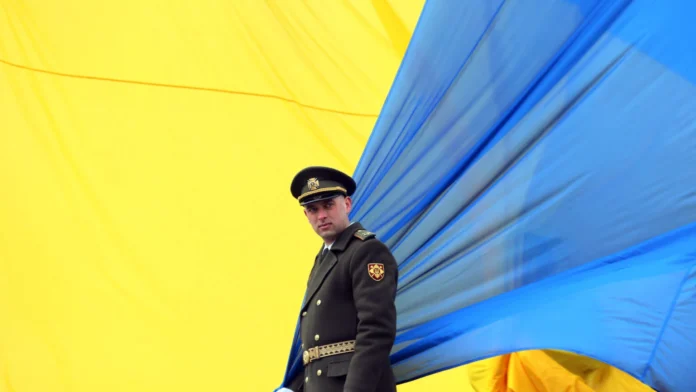On the two year anniversary of the war, the Breaking Defense team has assembled a series of pieces on the state of the conflict across multiple domains, what might come in year three, and what lessons the US has learned from the conflict.
WASHINGTON — Just before 5 AM on Feb. 24, 2022, Ukraine time, Russian forces began the invasion of Ukraine, with tanks rolling over the border and long-range strikes hitting Kyiv. It only took a week for what looked to be a short, bloody victory for Moscow became something else – Ukraine’s defenders stood strong and shocked Russian forces, who were proven to be a much more hollow force than even the most optimistic NATO planner could have hoped.
By one month in, the war settled down into a grinding conflict more reminiscent of World War I than the “shock and awe” campaigns of modern warfare. Two years in, the conflict has largely been frozen in that situation — each side has made and lost gains, but neither has delivered anything close to a knockout punch.
But just because the conflict has largely remained the same doesn’t mean things have not changed over two years. It also doesn’t preclude other nations — including the US — from taking lessons learned and applying them to their own battle plans.
On the two year anniversary of the war, the Breaking Defense team has assembled a series of pieces on the state of the conflict across multiple domains, what might come in year three, and what lessons the US has learned from the conflict.
Naval Domain: Drones, Blockades And Sunken Ships
In year two of the Ukraine war, the naval domain continued to be a lower-tier area of conflict — and yet, both sides stepped up their activities at, above and below the sea. The Ukrainians have particularly shown their prowess at using naval drones to deal significant blows to the Russian Navy.
Ukraine earlier this month claimed to sink Russia’s landing ship Cesar Kunikov with this very tactic. It was one high profile success story for Ukraine of its ability to use naval drones, but videos of similar attacks have spread on social media for the past two years. A senior US defense official told reporters last week it’s the Pentagon’s assessment that Ukrainian forces have sunk, destroyed, or damaged at least 20 medium to large Russian Federation Navy vessels and one Russian-flagged tanker in the Black Sea.
One of the reasons the use of naval drones has been so effective is that the Black Sea, relative to places like the vast expanse of the Pacific Ocean, is a contained space with easy-to-monitor choke points, said Jerry Hendrix, a retired Navy captain and a senior fellow at the Sagamore Institute, an Indianapolis-based think tank.
The war in Ukraine has “signaled a significant change in the way that we perceive naval warfare because Ukraine has demonstrated that there’s a huge asymmetric advantage in the use of drones and small unmanned vessels — [such as] jet skis with bombs on them,” he told Breaking Defense. “The vulnerability of surface ships that many of us have spoken about in the past seems all too real.”
Bryan Clark, a fellow at the Hudson Institute, said that while the concept Ukraine is using against Russia’s Navy — suiciding a cheap boat packed with explosives — is not inherently new, its success is likely due to modern technology that give operators greater control over the unmanned surface vessels themselves.
It’s a tactic that, while unlikely to work in the open ocean, is very viable in environments such as the Persian Gulf, the Black Sea and, most interestingly for the US Navy, the Taiwan Strait, he said. These kinds of one-way attacks are a cornerstone to a new report Clark, and Hudson fellow Dan Patt, released this week theorizing how the US might make use of similar tactics if it were ever forced to defend Taiwan from a Chinese invasion.
Another aspect highlighted by the war in Ukraine has been the devastating power of a naval blockade.
Russia has at times attempted to prevent Ukraine from exporting its grain to other parts of Europe and Africa. Beyond the damage such a blockade can cause to Ukraine’s economy, it’s particularly problematic for African countries where severe increases in the price of bread can cause civil unrest, Clark said.
“It’s a significant impact and now the restoration of that has taken away a lever that Russia was hoping to use against Ukraine,” he said.
Hendrix said the blockade’s disruption led the world to “wake up” to how dependent it is on unimpeded access to the sea. “The ocean is assumed [to be free] in everyone’s lives, and because of Ukraine, and now the Red Sea, suddenly the oceans are no longer assumed. Now, all of a sudden people are paying attention to the idea of free trade and free movement because they’re seeing what happens when it goes away,” he said.
And when it comes to the Black Sea, Turkey has a large degree of control over who has that freedom of movement, a power granted to it by the Montreux Convention, an international agreement signed in 1936.
Hendrix argued Turkey may have been able to pre-empt much of the war had it allowed US and allied naval forces to enter the Black Sea early in the conflict. But despite Turkey’s ostensibly favorable interpretations of international laws, Hendrix noted the Russian Navy has been reluctant to have ships stationed in the Black Sea leave — lest they not be allowed back in.
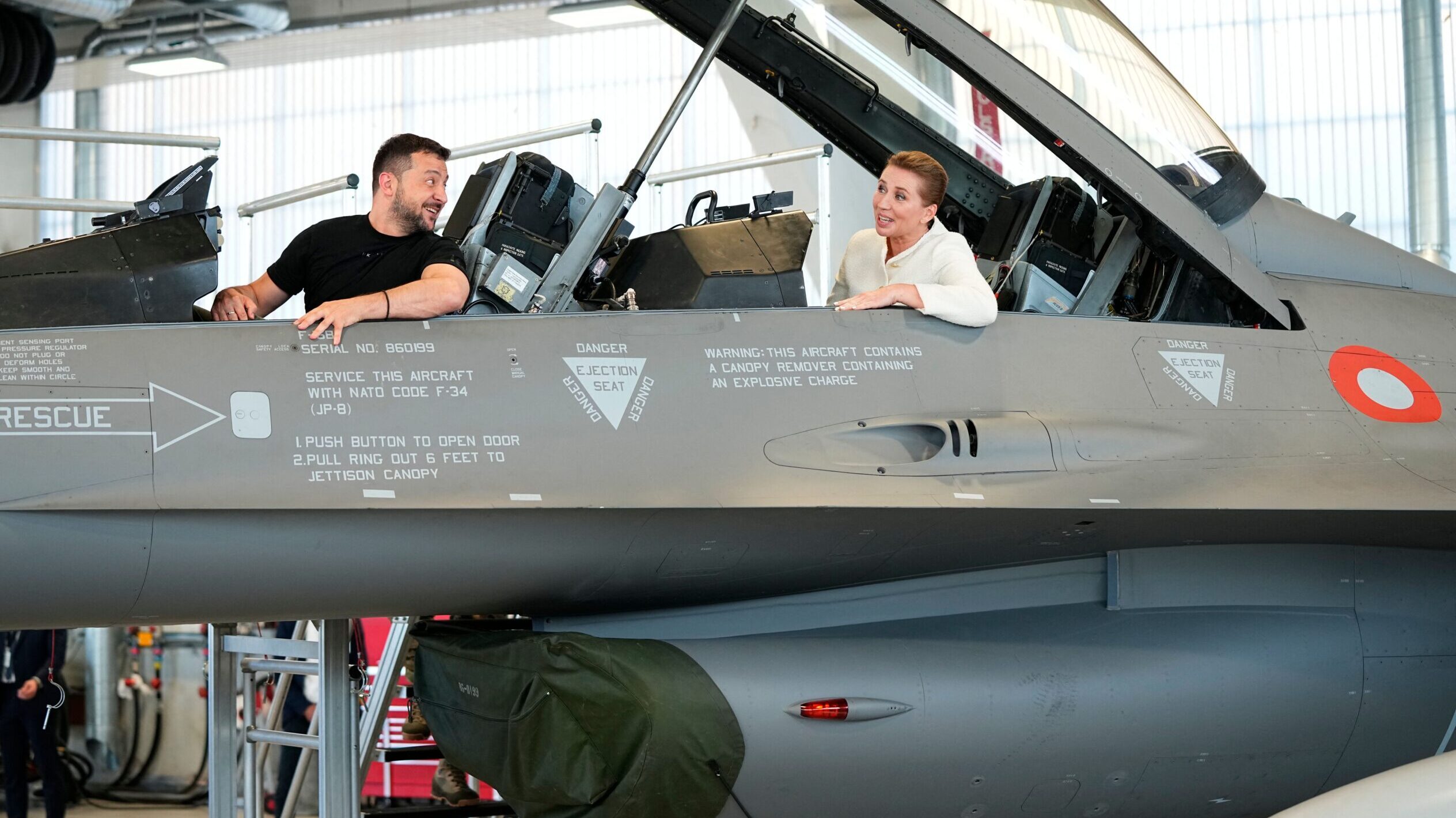
Ukrainian President Volodymyr Zelensky (L) and Danish Prime Minister Mette Frederiksen (R) react as they sit in a F-16 fighter jet in the hangar of the Skrydstrup Airbase in Vojens, northern Denmark, on August 20, 2023. (Photo by MADS CLAUS RASMUSSEN/Ritzau Scanpix/AFP via Getty Images)
Air Domain: Despite Pleas from Kyiv, Airborne Assets Remain Missing
High in the sky, little has changed since the opening days of the war. With air superiority mutually denied by highly effective integrated air defenses, Russian and Ukrainian jets typically have to fly low to evade detection and operate from standoff distances.
But in contrast to the first year of fighting, Ukraine’s reach has extended thanks to the shipment of longer-range air-launched missiles like the UK’s Storm Shadow, reportedly used to destroy the Russian submarine Rostov-on-Don and strike other critical targets. The US has also supplied the ATACMS ground-launched missile and is reportedly considering shipping a newer version with a greater range.
Tactics have also adapted. US officials, for example, have praised Ukrainian agile combat employment techniques to avoid Russian attacks as a model to emulate. Both Ukraine and Russia have additionally increasingly turned to drone warfare to conduct strikes, flying low to avoid detection until it’s almost too late.
The demands of the Ukraine war have led NATO allies to perform crucial functions in support of Kyiv. Platforms like the Boeing-made E-7 Wedgetail are flying regularly, according to the head of US Air Forces in Europe Gen. James Hecker. Speaking at a roundtable with reporters recently at the Air and Space Forces Association Warfare Symposium, Hecker said an Australian-owned Wedgetail operating in the region provides a “persistent ISR [intelligence, surveillance and reconnaissance] picture down to low altitude” where drones and missiles often fly.
The need for that ISR picture, Hecker said, has prompted officials to explore solutions like aerostat balloons.
Perhaps the biggest cry for help from Kyiv since the early days of the war is for a fleet of newer jets that can improve upon the Soviet-era fighters Ukraine’s limited air force has had to operate. Despite the hopes of Ukraine and its supporters, those jets did not arrive in time for the planned summer offensive against Russia, which has ended in, at best, a stalemate.
However, a milestone does appear to be visible as Ukraine prepares to take possession of F-16 Fighting Falcons donated from various users in Europe. During a separate roundtable with reporters at the AFA Warfare Symposium, Director of the US Air National Guard Lt. Gen. Michael Loh said Ukrainian pilots being trained under the aegis of the Guard are progressing, and in fact are “flying F-16s solo every day.”
The training, Loh said, will ensure they’re “qualified to do the full range of missions” required beyond simply flying the jet. According to Air National Guard spokesperson Lt. Col. Amber Schatz, a total of 12 pilots are set to train in the 2024 fiscal year. They will all graduate “between May and August,” and additional funding will be needed to train more, she said.
Several elements will still need to align for Ukraine to employ the Lockheed Martin-made fighters on the battlefield, Loh emphasized. For example, jets will need to be transferred by donor countries — 19 from Denmark, 24 from the Netherlands, two from Norway and an undisclosed number from Belgium beginning in 2025 — and a proper logistics infrastructure will have to be in place. Maintainers are currently at Joint Base San Antonio for English language instruction, though the location of their maintenance training “is still being determined,” Schatz said.
Separate pilot and maintainer training is also ongoing in Europe. In a statement Thursday, Danish Defense Minister Troels Lund Poulsen said that Ukraine’s first F-16s supplied by Copenhagen would arrive by this summer, a timeline affirmed by a subsequent statement from the Pentagon.
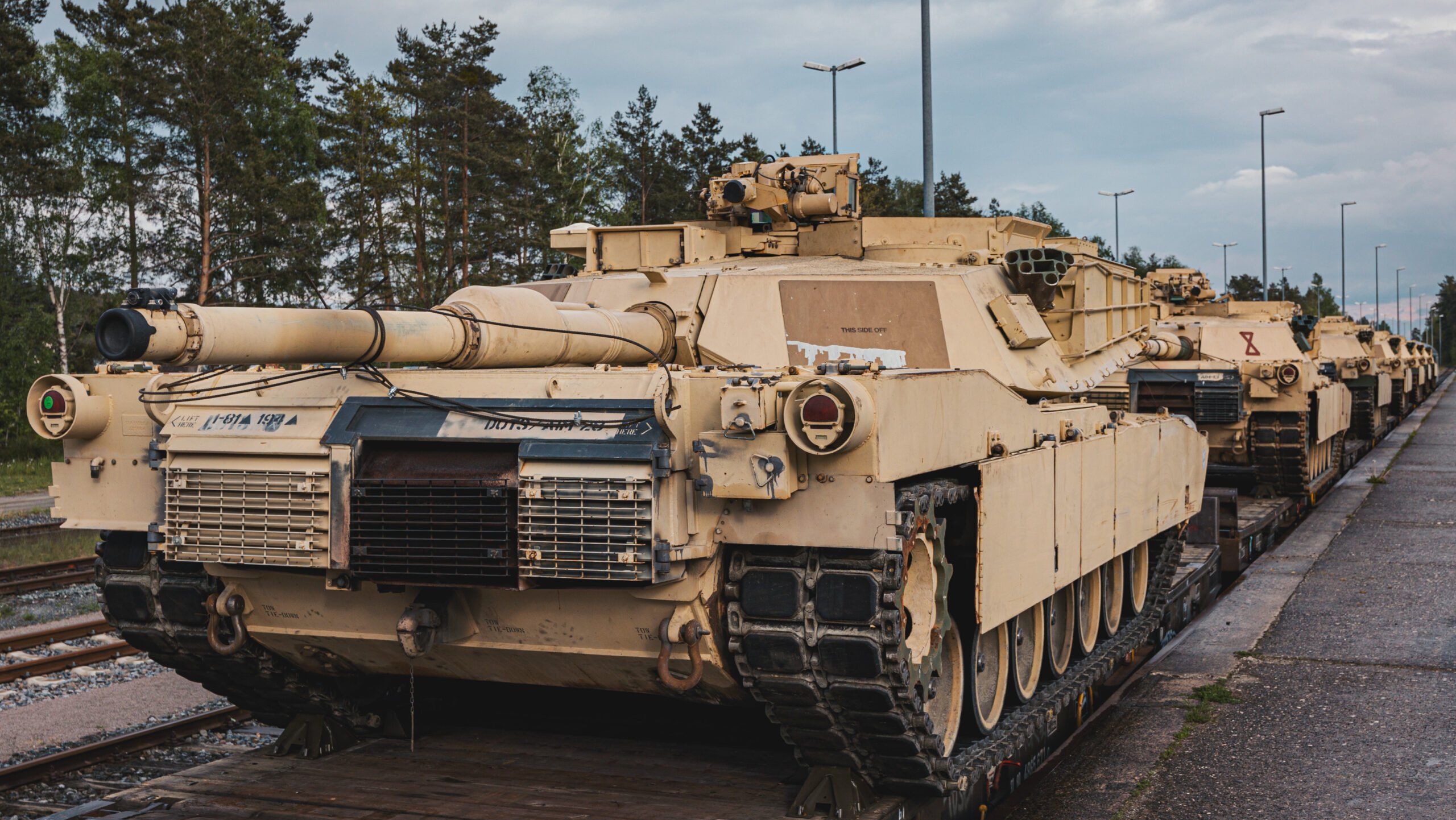
U.S. M1A1 Abrams tanks needed for training the Armed Forces of Ukraine await offloading at Grafenwoehr, Germany, May 14, 2023. (U.S. Army photo by Spc. Christian Carrillo)
Land Domain: Shifting Priorities From Lessons Learned
As Europe’s largest armed conflict since World War II grinds into year three, Ukraine’s allies and partners are continuing to look for ways to support Kyiv while gleaning lessons about how to evolve their own ground-based weapon systems and formations.
US Army Europe and Africa spokesman Col. Martin O’Donnell estimated that as of Jan. 31, the international community had trained more than 118,000 Ukrainian troops at over 80 different training areas located around the world. From that total, 16,300 soldiers attended training at the US Army bases of Grafenwoehr and/or Hohenfels in Germany, with 9,900 completing combined arms training, 5,100 completing platform training, and 1,300 finishing staff and/or leadership training.
But the coalition work goes beyond training to include monthly Ukraine Defense Contact Group (UDCG) meetings among roughly 50 countries aimed, in part, at identifying weapons to send to Kyiv. That work has included the establishment of eight capability coalitions — air force, air defense, artillery, maritime security, armor, information technology, de-mining and drones.
It’s the land domain where other European nations seem to have been able to make the greatest contributions. Poland, for example, recently stepped up to lead that new armor coalition and during a meeting earlier this month, member countries were signing up to participate.
“The goal here for the armor coalition that was discussed at the UDCG on Wednesday [Feb. 14] pertains certainly to the tank force, but also to other kinds of armored vehicle, and ensuring that Ukraine will have the right platforms but also, very importantly, the right ammunition for those platforms and the maintenance and sustainment,” a senior US defense officials told reporters later that week.
As the group solidifies in the coming weeks and months, potential announcements and changes could be afoot.
US Army officials are using the war as an opportunity to study what’s working and what’s not, and tweak modernization plans.
Some defense officials remain hesitant to cite specific “lessons learned” on the ground front but assert the war has shown that tanks and other armored vehicles remain relevant, as does maintaining a deep artillery magazine round and fielding new loitering munitions and counter unmanned aerial systems.
“There is still a place for tanks and armored vehicles on the battlefield: Yes, there are new threats but at the end of the day, if you want to take some ground away from someone and hold it, you’ve got to do it with armed forces,” US Army acquisition head Doug Bush told an audience at an International Armoured Vehicles conference last month.
Mass still matters as well. The IISS think tank recently said Russia has so far lost 3,000 tanks and is sacrificing “quantity over quality.”
Ukraine’s reliance on artillery has remained a constant this year, and is expected to continue for the foreseeable future. The current and future challenge will likely remain restocking those 155mm rounds. Just last month NATO announced a pair of deals valued at $1.2 billion for hundreds of thousands of 155mm rounds, while the US Army is also looking to shore up production; By the end of fiscal 2025, the service wants to be able to produce 100,000 such rounds each month.
US Army Tactical Missile System (ATACMS) have also made their way into Ukraine’s arsenal in year two, and there are reports that longer-range versions could be bound for the Eastern European country next year too.
Drones may end up being the defining weapon of this conflict, on both sides. The past year has showcased the proliferation of loitering munitions on the future battlefield, with the US sending Switchblade 600 attack drones to piece Russian armor, while Moscow uses ones like the Lancet-3.
For Bush and the US Army, these takeaways have directly trickled down to modernization programs, including last year’s decision to pursue a more ambitious M1 Abrams main battle tank upgrade than previously planned. While the service has not disclosed all the details about what it wants in that tank upgrade, they are eying one that weighs less, better protects soldiers inside and reduces the logistics burden.
Another modernization change thanks to lessons learned came from the decision this month to cancel the Future Attack Reconnaissance Aircraft (FARA) program, with Army Chief Gen. Randy George specifically saying the decision was driven by seeing how drones operated in Ukraine. Army leaders plan to reinvest funding from FARA, in part, in building out unmanned capabilities.
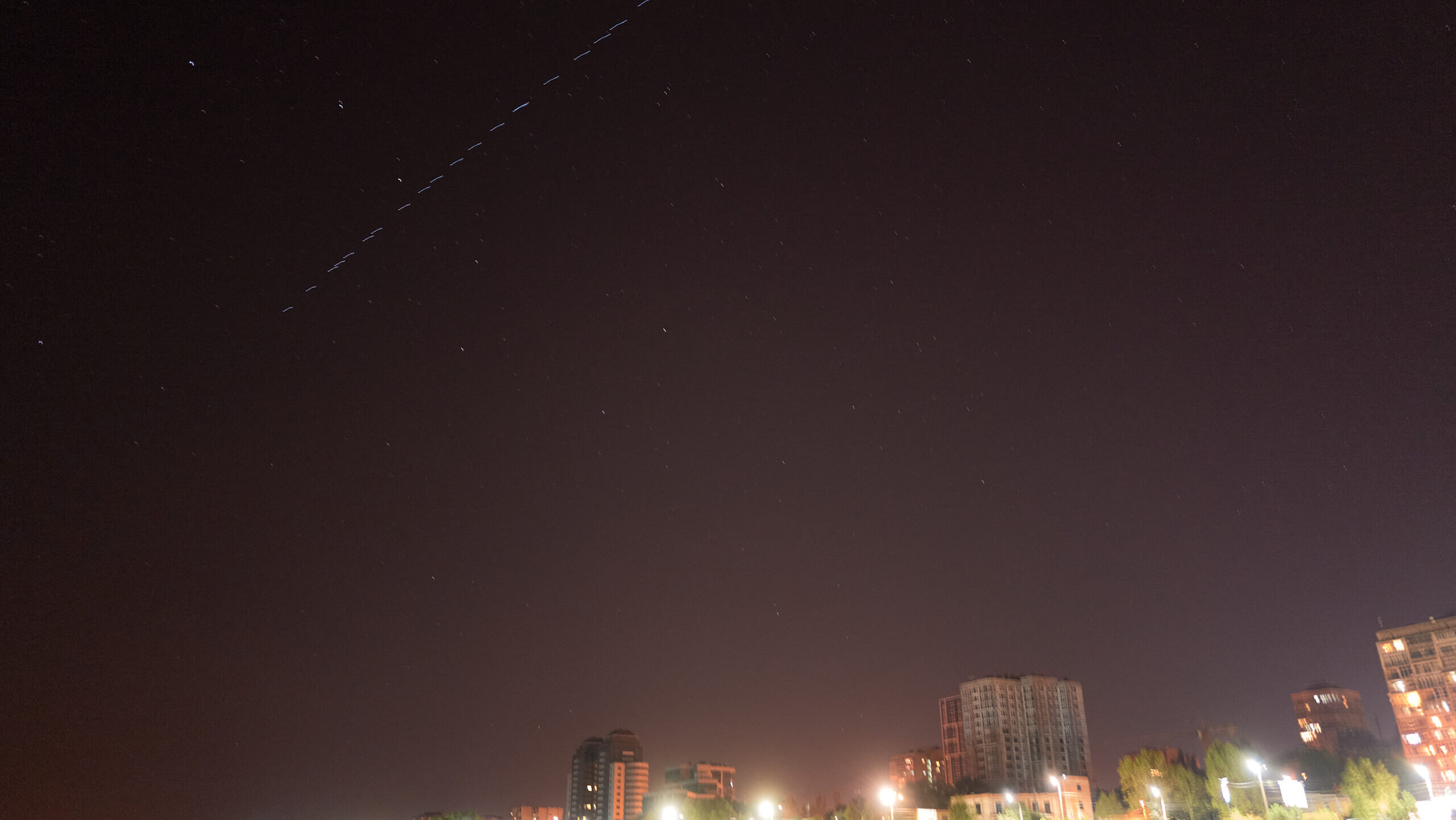
A constellation of Elon Musk’s SpaceX Starlink satellites fly above Zaporizhzhia as local residents fish at night on the Dnipro River on September 14, 2023 in Zaporizhzhia, Ukraine. (Photo by Pierre Crom/Getty Images)
Space Domain: Commercial Sector Steps Up
Russia’s invasion had hardly begun when the value of commercial satellites to Ukraine’s resistance became clear — when billionaire Elon Musk stepped into the breach left by Moscow’s pre-strike cyber shutdown of Viasat’s satellite communication network with Starlink. Within a week after Russian troops crossed the border, Ukraine had access to Starlink’s space-based internet services and hundreds of terminals were flooding into the country.
Starlink has been used ever since in Ukraine, not just to keep citizens and the government connected to the outside world and the economy functioning, but also in support of Ukraine’s military forces. The network provides military communications, as well as guidance for Ukrainian drones and missiles. And because of Starlink’s configuration, involving thousands of satellites in low Earth orbit using small antennas and encrypted signals, so far Russian attempts to jam it have largely failed.
Indeed, it seems that Russia now is taking an attitude of “if you can’t beat ’em, join ’em” on Starlink. As first reported by the Wall Street Journal, Ukraine earlier this month asserted that Russia now is acquiring and using Starlink itself in the Ukrainian territories it has captured — although Musk publicly has denied that SpaceX has provided access or terminals to Russia. On Feb. 19, Reuters reported that Ukraine’s Deputy Prime Minister Mykhailo Fedorov told national television that the government has “is working with” SpaceX on how to block Russian usage of the network.
Though Starlink has been the most public — and perhaps predictably given Musk’s outsized and often erratic personality, the most controversial — example, a number of other US commercial satellite companies also have played key roles in Ukraine’s resistance up to now.
These primarily are firms involved in commercial remote sensing, whose abilities have allowed Ukraine’s government and military leaders to keep eyes on Russian troop movements, as well as its own forces. These companies — including Planet, Maxar Technologies (recently acquired by Advent International), BlackSky, Capella and Hawkeye360 — also have been key in keeping the public in the US and around the world informed about the war, helping the US government establish a counter-narrative to Russia’s active propaganda campaign.
In contrast to the Starlink situation, however, it is the US Intelligence Community that first spurred the release of commercial remote sensing images and data to assist Ukraine. Obtained under contract by US spy agencies, that data also has been shared with US NATO allies and partners to keep them informed (and presumably on-side) about the ongoing war — leading to an initiative last February by the US, Canada and 16 European countries to more freely share remote sensing data.
Gen. Chance Saltzman, the Chief of Space Operations, has been touting the lessons needed to be learned by the Pentagon from Ukraine’s use of space systems since even before his confirmation. He told the Senate in a Sept. 13 hearing that in particular Ukraine has proven the effectiveness of commercial space systems. Perhaps even more importantly, the war has established that networks comprising many small, less costly satellites rather than few, super-capable ones are harder to attack.
And since then, Saltzman has pushed to integrate those two key lessons into the Space Force’s efforts to remake the structure of US military space forces to face future challenges. While success so far has been mixed, it remains early days.
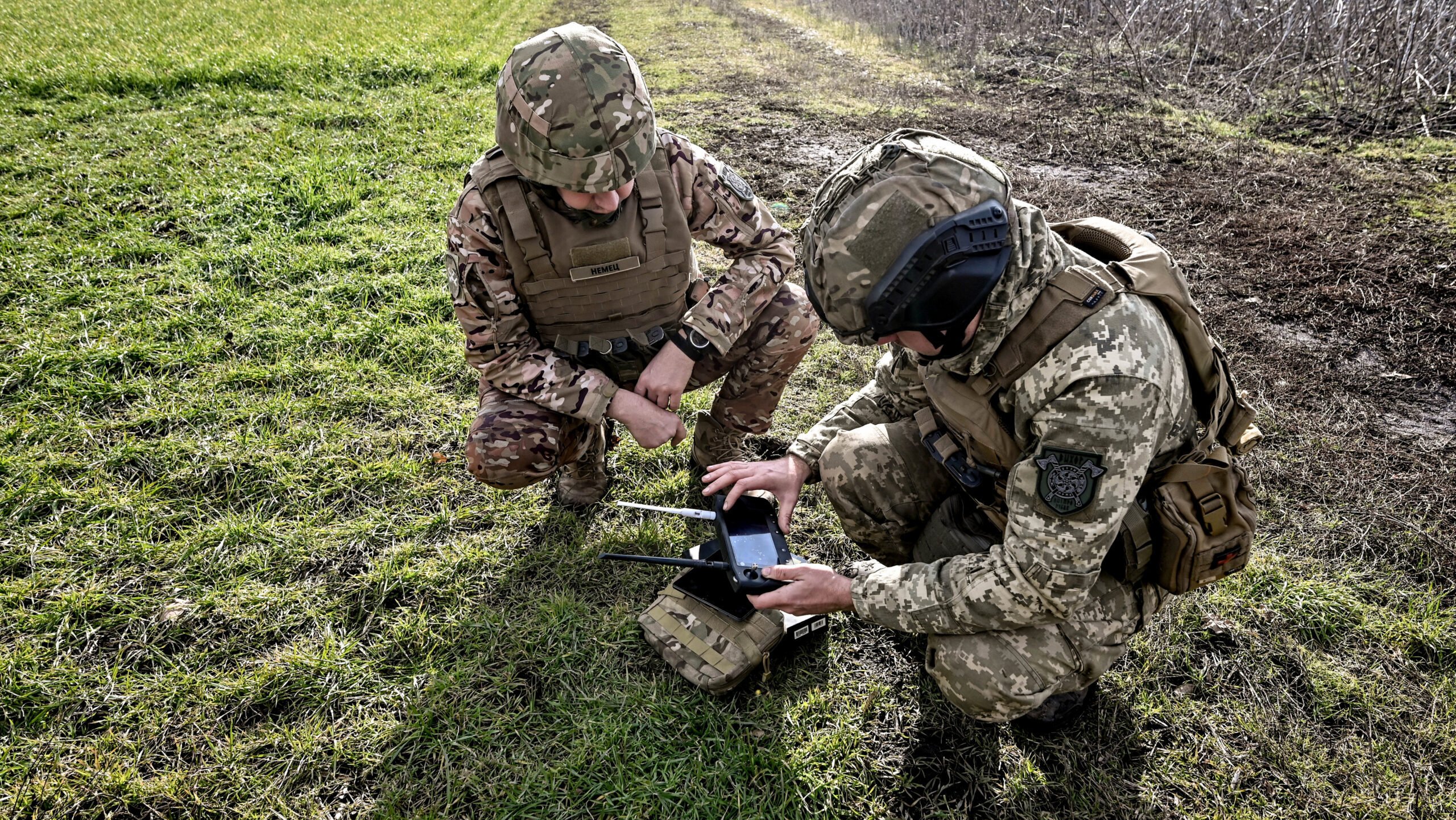
Servicemen of the Vykhor Dnipro unmanned combat aerial complex platoon of the 108th Separate Territorial Defence Brigade show the launch of a Vampire drone, a Ukrainian unmanned combat aerial vehicle (UCAV) which is equipped with a thermographic camera, Zaporizhzhia region, southeastern Ukraine. (Photo credit Dmytro Smolienko / Ukrinform/Future Publishing via Getty Images)
Electronic Spectrum: Combat On The Airwaves
As in the ground war and at sea, Russia began the cyber/electronic war with attempted knockout blows in 2022, only to suffer startling reverses at the hands of unexpectedly resilient and adaptable Ukrainians. Last year, however, saw Russia rushing to catch up, resulting in a seesaw back-and-forth that averaged out to bloody stalemate.
For instance, Ukraine had led the way in adapting small civilian drones to military use as scouts and mini-bombers. Russian authorities, by contrast, have disdained such systems and invested heavily in larger, purpose-built military systems. But 2023 saw the Russian side catch up, with the Ministry of Defense bureaucracy dragged forward by patriotic, self-organized volunteers — a rarity in Russia — who not only still donate most of the nimble FPV (First Person View) “racing” drones using for precision strike, but even train many of their pilots, according to CNA expert Samuel Bendett.
“The volunteers … are still complaining that the country’s defense industrial sector is not fully involved in FPV drone manufacturing,” Bendett told Breaking Defense.
Despite these obstacles, both sides began using commercial mini-drones by the thousand — and losing them in their thousands to electronic warfare. (That prompted as-yet-unsuccessful efforts on both sides to install AI, which would let the drones operate without constantly communicating with a human controller).
Russian electronic warfare forces adapted too. Hudson Institute EW expert Bryan Clark noted in a recent AOC webinar that Russian ground forces were lavishly equipped with radio detection and jamming vehicles to start the war, but those capabilities were optimized against a NATO adversary, not Ukraine. For example, Russia invested heavily in big, powerful jammers intended to disrupt big, powerful NATO systems, like JSTARS radar planes or military communications satellites in high, geostationary orbits (GEO). But Ukraine’s fledgling air force never had anything like JSTARS to jam.
Now, Ukraine did have GEO communications: A commercial satellite network, run by Viasat, provided the backbone of Ukrainian military communications before February 2022. But a successful Russian cyber attack crippled the network on the eve of the invasion, which forced Ukraine to switch to Elon Musk’s Starlink. And Starlink had a radically different architecture that used thousands of small, low-powered satellites in Low Earth Orbit (LEO) — far too many, moving far too swiftly, with software updated too fast, for Russian EW to disable. So bulky Russian jammers like the truck-mounted Krasukha-4 proved useless against the new Ukrainian approach and were withdrawn, Clark said. But as 2023 ground on, again, the Russians adapted, eventually deploying larger numbers of smaller, more maneuverable, and shorter-ranged jammers that targeted not the satellites, but the Starlink terminals and other Ukrainian radios on the ground, as well as drone control links.
The US military has taken these lessons to heart. The Army in particular is ramping up tactical electronic warfare with its drone-mounted MFEW pods and truck-borne TLS, Clark noted. All the services are interested in proliferated LEO satellites and (by US standards) low-cost drones, with the Defense Innovation Unit leading the way on the ambitious all-service Replicator initiative.
One crucial unanswered question, however, is how well the short-range drones and jammers of the Ukrainian land war will translate to the West Pacific, with much longer distances and a more high-tech adversary.
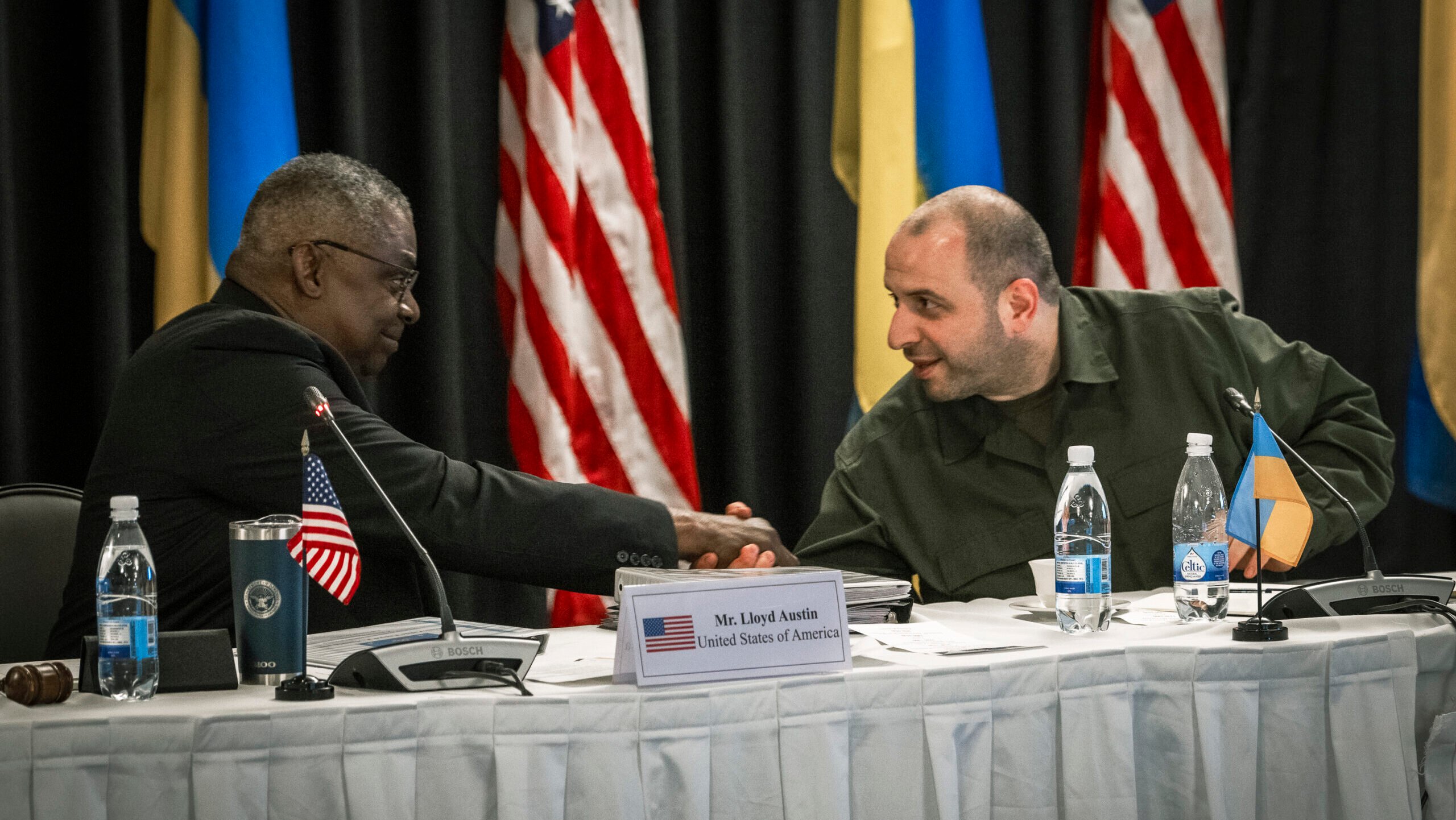
Secretary of Defense Lloyd J. Austin III and Ukraine’s Defence Minister Rustem Umerov speak at the 15th meeting of the Ukraine Defense Contact Group at Ramstein Air Base, Germany, Sept. 19, 2023 (DoD photo by Chad J. McNeeley)
Geopolitics: Washington Chaos, European Drive
A DoD factsheet of what the US has sent to Ukraine shows the sheer scale of the combat over two years: more than 2 million 155mm shells, 10,000 Javelin missiles, over 250 Bradley, Abrams, Stryker and Howitzer vehicles.
And yet, perhaps the biggest challenge facing Ukraine’s government right now is the wavering support from Washington, where desperately needed funding has been tied up for months in Congress.
When the Ukrainian city of Avdiivka fell last week, the White House specifically linked its collapse to Congressional inaction. President Joe Biden, who has been pushing a supplemental for Ukraine’s aid, told reporters “The idea that now they [Ukraine] are running out of ammunition, and we walk away. I find it absurd. I find it unethical.”
Meanwhile, former president Donald Trump is locked in as the GOP nominee, meaning his influence over Congressional Republicans is only strengthening. Trump set the European defense community afire with a recent threat to let Russia do “whatever the hell they want” and attack NATO allies that have not contributed enough spending to the alliance, and much of the resistance to supporting Ukrainian funds is tied back to his stances towards the conflict.
In Europe, officials remain fully committed to the end goal of Ukraine winning the war, but they are increasingly fearful of how that happens without unconditional US support
Still, there have been unmistakable increases to defense spending across Europe since the war in Ukraine started, leading to a steady series of approvals for lucrative military aid packages to support Kyiv and new weapons contracts with industry to restock equipment inventories.
In line with this unprecedented funding, NATO expects European allied defense spending to reach a combined total of $380 billion this year, backed by 18 member states hitting the 2 percent GDP alliance spending target. Such a seismic shift in just two years is notable, but still lags, on a like-for-like basis, some way behind Russia, which has moved to a war footing economy. Moscow’s national budget is currently used for military spending and is soon expected to reach 7.5 percent of the country’s GDP, according to International Institute for Strategic Studies (IISS) think tank figures.
In the early stages of the war, Europe was also gripped by fears of the war escalating, concern that tended to dominate political debate and best exemplified by resistance to supply Kyiv with MiG-29 fighter jets and Leopard 2 main battle tanks. (Both platforms have since reached the frontline.) Germany’s continued refusal to send Taurus cruise missiles, despite the UK and France sending Storm Shadow and SCALP long range weapons, shows that Berlin still considers escalation a fundamental problem.
As critical as military aid packages have been, supplies of new weaponry have not delivered a decisive battlefield advantage, while an acute ammunition shortage across Europe continues to frustrate Ukrainian officials. Ukraine requires an additional 240,000 shells a month to keep parity with Russia’s frontline output alone, according to an Al Jazeera report, and it is unclear where that ammunition is going to come from.
The fall of Avdiivka, the first major territorial loss to Russia since last May, has only underlined the challenges now facing Kyiv’s military strategists, who may need to begin deciding where to parcel out munitions.
At a wider equipment and economic level, Russia has suffered hugely damaging losses over the course of the war. At least 315,000 Russian forces have been either killed or wounded, a senior US defense official told reporters last week. Moscow has also likely spent up to $211 billion in direct financial outlays to equip, deploy, maintain and sustain Russian operations in Ukraine, said the US defense official.
Even so, Russia’s threat shows few signs of abating, with European political and military leaders making that case time and again. Take Estonia’s Prime Minister Kaja Kallas, claiming an attack by Moscow on a NATO nation could be just three years away, or Patrick Sanders, head of the British Army, calling for a British “citizen army” to be stood up in case of an invasion. Those are just two of the more headline grabbing remarks to have really put in perspective that Russia is anything but a beaten or diminished force.
As year three of the conflict gets underway, it seems Moscow’s strategy is a simple one: keep grinding down Ukraine inch by inch, and hope Kyiv exhausts its supply of both bullets and political backing across the globe.
https://breakingdefense.com/2024/02/ukraine-war-turns-2-lessons-learned-and-what-comes-next/?utm_medium=email&_hsmi=295478420&_hsenc=p2ANqtz-_X1L8x1HwWiFfg7_mvDrlBLBx3Sl1aDIVUnquPPbzGq4G4loFc0FNlbmkN326Cdsq1lRy4fBo2N2xwg6yZKKcPOyu7hA&utm_content=295478420&utm_source=hs_email



